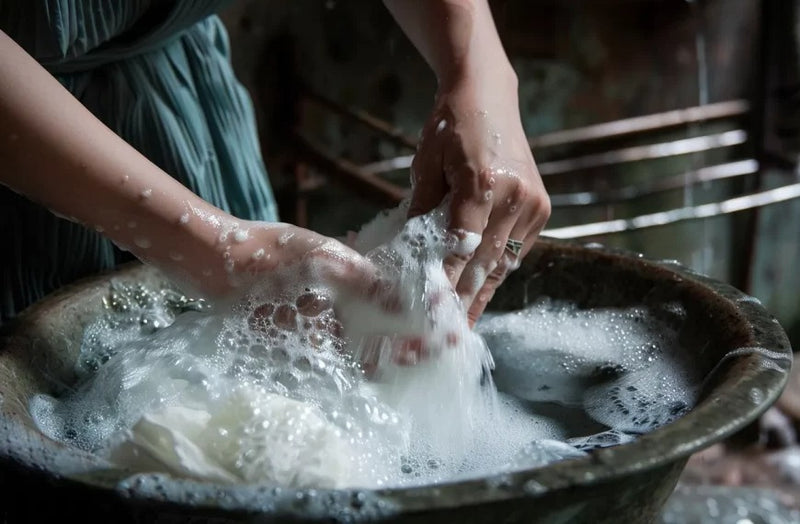
Now you find that your dress is made from gauze fabric, one of the excellent fabrics suitable for spring, summer and fall. But do you know how to wash it? Don't worry. Following the guideline.
Start by pre-washing gauze fabric to remove excess dye and allow for shrinkage. To maintain its color, add vinegar in the wash. Always wash gauze in cold water; this helps protect its integrity and prevents color bleeding. Keep it separate from other items to avoid snags. Use a gentle machine cycle with a mild detergent to avoid fraying and damage. After washing, tumble dry on low heat or let it dry flat. Try to avoid ironing. Following these tips, your gauze fabric will maintain its shape and texture. There's plenty more to learn about fabric care, so don't stop exploring!
Key Takeaways
- Pre-wash gauze fabric to remove excess dye and allow for possible shrinkage, ensuring accurate sizing after sewing.
- Add vinegar to the wash to set color, prevent fading and maintain the fabric's vibrant appearance.
- Wash gauze fabric separately in cold water with a mild detergent. This will protect the fabric and prevent colors from bleeding.
- Use a gentle cycle to avoid fraying and consider using a laundry bag for additional protection.
- After washing, tumble dry on low heat or lay flat to dry, avoiding ironing to preserve the fabric's crinkled appearance.
Should you Pre-wash Gauze Fabric Before Sewing?
Gauze fabrics are a great choice for baby apparel. Please pre-wash the gauze fabric before starting your sewing project. This will remove excess dye and chemicals and prevent any potential shrinkage or expansion. This process not only softens the fabric but also ensures accurate sizing later on. If not pre-washed, the fabric may shrink post-sewing, distorting your final product.
By washing in cold water, you're also testing the colorfastness of the fabric, as some dyes may bleed. You'll want to avoid this, especially when working with bright or dark hues. Pre-washing also rids the fabric of any stiffness, providing a smoother, more comfortable end result.
Tips for How to Wash Gauze Fabric Properly

When washing gauze fabric for the first time, consider adding vinegar to set the color and prevent fade. Always wash your gauze fabric in cold water. If you're using a machine, wash it separately and choose a gentle cycle to avoid fraying.
Add Vinegar to Set the Color When Washing Gauze Fabric for the First Time
Add 2 tablespoons of white vinegar to the first wash cycle to keep the colors of your gauze fabric vibrant. This simple, yet effective method can significantly help in setting the color.
The vinegar acts as a natural color fixative, preventing the colors from fading or bleeding. It's especially useful for maintaining the appearance of delicate or brightly colored gauze fabrics.
The role of vinegar extends beyond just setting the color. It helps to preserve the color of the fabric, so your gauze fabric stays looking new even after many washes.
Wash Gauze Fabric in Cold Water
Wash your gauze fabric in cold water to keep it soft and breathable for longer. This method of care protects the cotton's integrity, preventing shrinkage and preserving its delicate nature.
Remember, cold water doesn't just keep the fabric from damage. It also prevents excessive color bleeding, helping your fabric retain its vibrancy. It's wise to use a mild detergent in your cold water wash, ensuring your gauze fabric remains soft and breathable.
This gentle method, recommended by fabric care experts, will extend the life of your gauze clothes and make them more comfortable. Therefore, when washing your gauze fabric, always opt for cold water to guarantee optimal results.
Machine Wash Gauze Fabric Separately
It's important to wash your gauze fabric in cold water and pay special attention to the washing method to keep it in good condition for a long time. It is crucial to wash gauze fabric in the washing machine separately. This separate wash prevents snagging or tearing that might occur if mixed with heavier fabrics.
Using a mild detergent is vital, as harsh chemicals can damage the delicate fibers. Always opt for a gentle cycle; this is gentle enough to clean the fabric without causing harm. To wash delicate fabrics like gauze, use cold water, mild detergent, and a gentle cycle.
Use a Gentle Cycle to Prevent Fabric Fraying
When you wash gauze fabric, use a gentle cycle on your washing machine to prevent the delicate fibers from fraying. This approach safeguards the fabric's integrity and ensures a long lifespan.
To further protect your fabric, consider using a laundry bag. This precaution helps prevent snagging or tearing during the wash cycle.
Care Instructions After Washing Cotton Gauze Fabric

After you've washed your cotton gauze fabric, it's crucial to handle it correctly to maintain its quality. You should either tumble dry it on low heat or lay it flat to dry, avoiding high heat that can damage the delicate fibers.
Tumble dry gauze fabric on low heat or lay it flat to dry.
Proper drying of your gauze fabric plays a pivotal role in maintaining its quality and longevity. To ensure this, tumble dry the fabric on low heat. This method prevents damage and maintains the gauze's delicate texture.
However, you've got another effective option. You can also lay the fabric flat to dry. This technique minimizes wrinkles and helps preserve the fabric's original shape. But remember, high heat settings are a no-go. They can cause your gauze to shrink and potentially damage the fabric.
Don't iron gauze fabrics if possible.
Despite the temptation to iron your gauze fabric for a smooth finish, it's best to avoid this practice whenever possible. Gauze is a delicate material, and ironing can lead to distortion or damage.
Gauze is lightweight and airy, but ironing it too much can make it shrink or lose its soft texture. Instead, after washing, let your gauze air dry or tumble dry on low heat.
This method not only preserves the fabric's inherent, crinkled appearance but also extends its lifespan. Embrace its natural texture and remember: no ironing.
Hanging gauze cloth away from sharp objects.
Hang your gauze fabric in a safe place to avoid damage from sharp objects. Safeguarding your soft gauze involves choosing a suitable area for hang drying, preferably where there's ample air circulation. This helps to maintain the fabric's quality and softness.
Moreover, avoid direct sunlight as it could lead to fading. Use padded hangers or clips to hang your gauze garments without causing any damage. Lastly, always store your gauze cloth in a cool, dry place. This not only helps to maintain the fabric's quality but also prevents wrinkles.
Conclusion
Now you know the ins and outs of caring for gauze fabric. Stick to these guidelines and your gauze fabric will stay fresh and beautiful, giving your sewing projects that professional touch.
Learn more about fabric knowledge at Longan Craft Blog, and dive into the fabric world with Longancraft!

0 comments